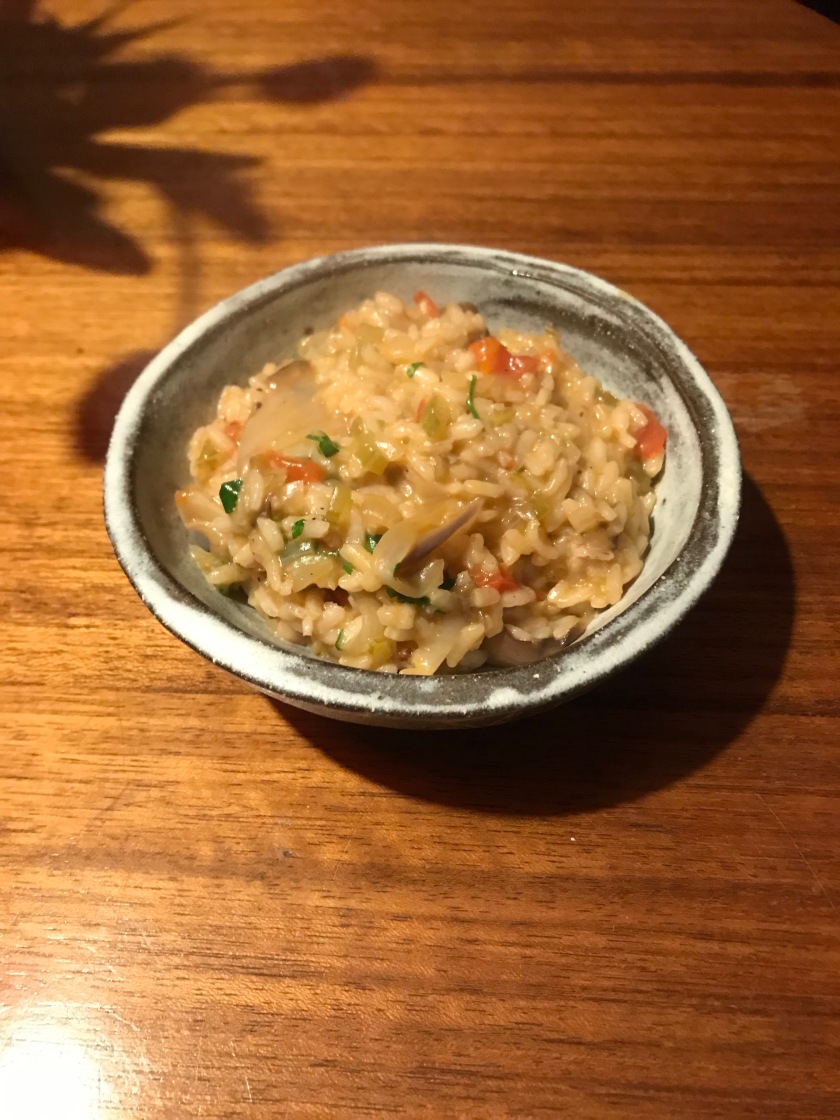
You may have read my account of a weekend in Rome last October. The weather was apocalyptic, I had a full on head cold, but the day of artichokes at Latteria Studio learning so much from Carla Tomesi and Rachel Roddy, was an antidote to everything. A feast of knowledge and a bloody good lunch to boot. I have written at length and often about my unseemly love of artichokes, so I shall spare you a repeat here.
In some ways, it was a kind of a torture – spending that weekend surrounded by most loved vegetable flowers; everywhere I looked, they were on offer. And knowing that when I came back to Birmingham, it would be to an artichoke drought, broken only when (and as it turns out, if) I could get down to London’s markets, or when my young allotment plants decide to throw up their own flower buds (I’m still waiting for anything that you could tentatively call a ‘glut’).
I went to be shown a myriad ways to cook with artichokes, in the full knowledge that buying the quantities needed for some the recipes would bankrupt me, especially if I had to get them singly and cellophane wrapped from Sainsbury’s.
One dish in particular stuck in my food brain, niggling away with thoughts of “will I ever have this again?” Artichoke lasagna. A vegetarian layering of pasta, cheese and artichokes. Spanking hot and with a glass of teeth achingly cold white wine, this will be my death row meal (well, one of them). Whilst it’s a dish for winter and early spring in Rome, here, if you’re reliant on your own crop, it’ll be a summer treat. I have been missing this dish since October, dreaming of a day when I am rich enough to not care how many artichokes I have just bought, or somehow, have managed to persuade someone to give me gainful employment in Italy, so I can move there, just for the artichokes.
But then in the perverse way of the world, the UK want into lockdown, the panic buying stripped the shops, and bafflingly, this provided me with the wherewithal to finally break my lasagna fast. I was told of delitalia, an Italian catering supplier that a) had flour, a lot of flour and b) was now doing domestic deliveries to Birmingham. Of course there was a small catch, just a minor detail; you still had to place catering size orders. My cupboards and freezers are already overflowing with food from the allotment and ingredients I thought I ‘needed’ at some point. And it’s not that I’m a hoarder, just that I’ve always regarded Best Before dates as mere guidance for the wise. So, whilst the product list was temptingly extensive, I had to restrict myself to things that I really would use, and would buy anyway over the next year. Flour yes, I’m already a third of the way through it (and have turned into the go to ‘flour man’ for my isolating neighbours), oil yes – 5 litres of olive oil will see me through the next year. And then there they were, jumping out at me as though lit in neon; frozen artichokes, prepared and raring to go. Minimum order, 5kg. Yes, I am that much of an idiot.
A freezer drawer was cleared (I had to eat a lot of ice cream that week, a hardship) and now I have what should be a year’s worth of my favourite vegetable, but realistically, I don’t think they’ll see out lockdown.
As they arrived, my first artichoke flower formed on one of the allotment plants. This I prepped, battered and fried – I wanted to memorialise its perfection. It was literally a taster, for the main, the lasagna.
I urge you to find a way to make this (even if it means having to buy catering quantities of flour and olive oil). The version I ate in Rome was Rachel’s, and my memory of the details is not perfect. So when I get hold of the real thing, I may come back and do an update. The potatoes were an addition suggested by Italianhomecooking – and he is right, the additional texture brings another bauble to this dish.
As I write this, I am reheating the half I did not eat last night, for my lunch. There will be some bread too (I have to get through that flour after all) . It will be just as good second time round I know. All sweet anaesthetic on the tongue artichoke, cheese and carbs. Un buon pranzo.
Artichoke Lasagna
(This made enough for two large portions)
The recipe will get refined over time – as I was making this up as I went along. If you are lucky enough to have access to abundant and affordable fresh artichokes, substitute those for the frozen ones, prepped into quarters, as shown in the photos below. If using frozen ones, check them, some may still have a few tough petals attached, which can take all the fun out of them.
Artichokes
A cereal bowl’s worth of prepared artichoke hearts (defrosted)
One small onion, chopped.
1 garlic clove
Salt and pepper
Glug of white wine.
Oil
Put the oil into a large frying pan (which has a tight-fitting lid) and as it warms, add your artichokes, onion and crushed garlic, and once they start to fry, throw in the wine, quickly turning down the heat, and slipping the lid on. These need to cook until the hearts are tender and yield easily when stabbed with a knife.
Remove from the heat and blitz 2/3 of the artichokes into a puree with blender (check the seasoning), keep the remaining third whole.
Bechemel Sauce
Flour 25g
Butter 25g
Milk (I used 700ml)
Salt and pepper
Melt the butter, and then add the flour, cooking it, but not allowing it to brown.
Gently, very gently, add milk. A tiny bit at a time to begin with.
The starch in the flour will suck upon the milk and swell like something from a sci fi film. If you add too much milk, it’ll be impossible to get rid of any lumps.
When all the milk is absorbed and and you’ve beaten the flour paste into smooth submission, add a spot more milk. Repeat the process patiently, and you’ll end up up a smooth, glossy white sauce the consistency of expensive emulsion paint. Seaso again, this is vital, as this sauce, together with the ricotta, could make a bland filling if you’re not brave with the salt here.
The rest
Lasagna sheets (I used premade, dry, as I had some in the cupboard, left by a former lodger (the wonderful Simon, who named his son for me), but if you prefer to make your own fresh, go ahead).
3 floury potatoes (peeled, boiled and sliced)
Ricotta (one tub)
50-75g (or as much as you like) Parmesan or Pecorino if you can get it.
Assemble your Lasagna
In a deep pie dish, place a third of your potatoes, artichoke hearts, and the puree. To this add a third of the ricotta and grated parmesan. Pour over a quarter of the bechemel, season. Add a layer of lasagna sheets.
Repeat another layer of vegetables, cheese and sauce, top with more lasagna sheets.
One final layer, and then pour the last of the béchamel over the lasagna sheets. You can grate some more parmesan over this if you like.
Into the oven at gas mark 4, for 30-40 minutes, until it is bubbling and golden. Ideally some of the lasagna sheets will have started to curl and crisp up, for another layer of crunchy texture.
Eat straight from the oven, or reheat the next day (assuming you have leftovers).





